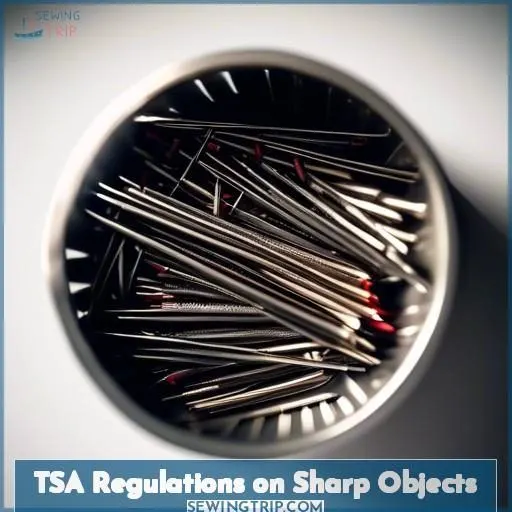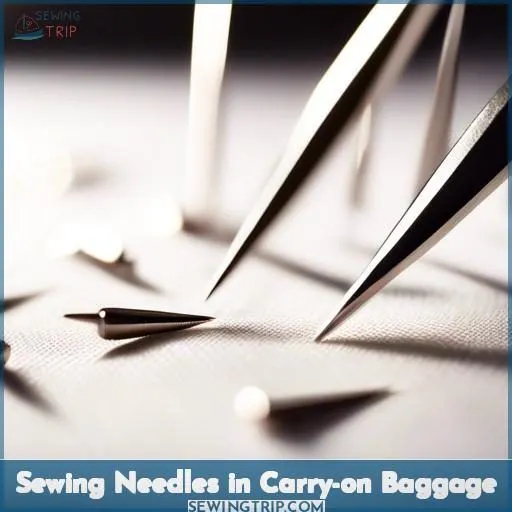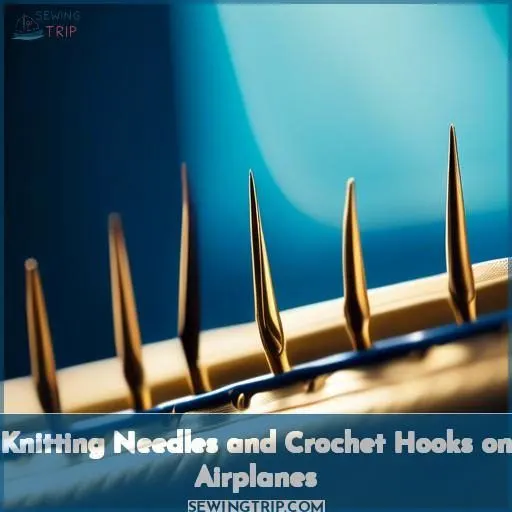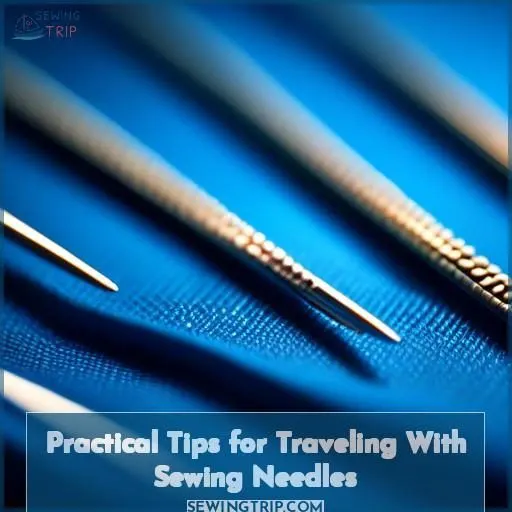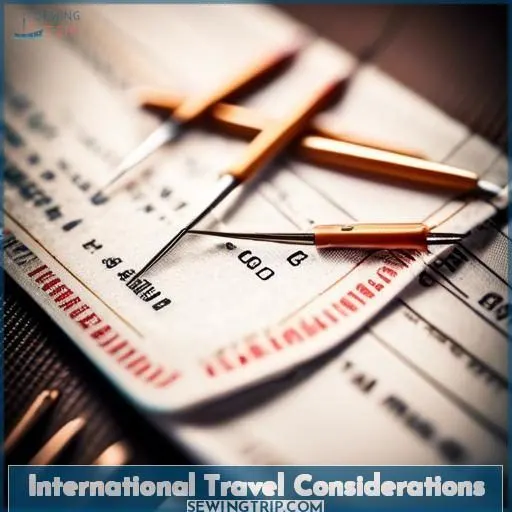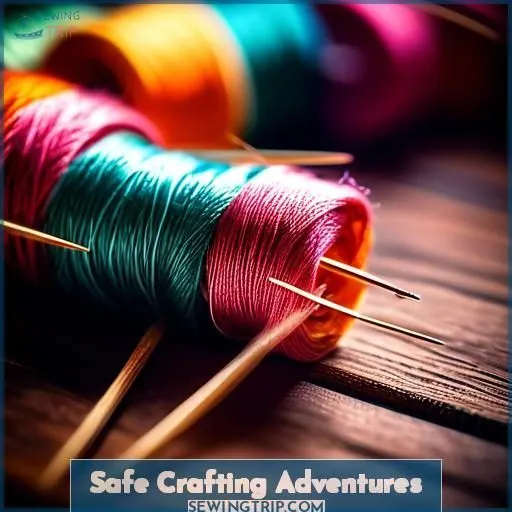This site is supported by our readers. We may earn a commission, at no cost to you, if you purchase through links.
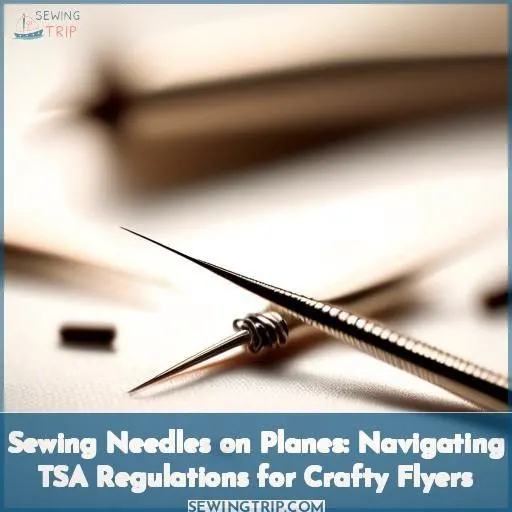
You can bring sewing needles on a plane in your carry-on luggage.
However, you’ll need to pack them safely.
The TSA permits small, blunt-ended sewing needles.
You should store them in designated needle cases or holders to avoid pricks and delays.
When packing, think about the needle type and purpose.
Hand-sewing needles are less likely to cause concerns.
Be ready to explain why you have sewing needles if asked.
Following these guidelines ensures that your crafting tools don’t obstruct your trip.
There’s more to learn for hassle-free travels.
Table Of Contents
Key Takeaways
- Sewing needles are generally allowed in carry-on luggage, but they must be packed securely to prevent pricks and delays.
- TSA regulations on sharp objects allow small, blunt-ended sewing needles, but large scissors, box cutters, and razor blades are not permitted.
- When traveling internationally, rules for sewing needles may vary between countries and airlines, so it’s essential to research the specific regulations of the departing and destination countries.
- Hand-sewing needles are typically less likely to cause issues, but be prepared to clarify the purpose of sewing needles if questioned by TSA agents.
TSA Regulations on Sharp Objects
Concerning traveling with sewing supplies, it’s crucial to know the TSA’s regulations on sharp objects. Sewing needles and tiny scissors are typically permitted in carry-on luggage, but you’ll want to steer clear of packing items such as large scissors, box cutters, and razor blades to guarantee a seamless security screening procedure.
Accepted Tools in Your Carry-On
When flying, your carry-on can include a few sharp objects without raising eyebrows. Here’s what makes the cut:
- Sewing needles: For quick fixes or intricate projects.
- Knitting needles and crochet hooks: Keep your hands busy and the creative juices flowing.
- Cross stitch needles: Begin a fabric adventure above the clouds.
- Micro scissors: Snip away with these tiny, TSA-friendly cutters.
Items to Avoid Bringing on Board
TSA prohibited items include large scissors, rotary cutters, box cutters, utility knives, and razor blades. These items aren’t allowed in carry-on baggage.
Sewing needles are generally allowed, provided they’re packed securely to prevent pricks and delays. Sewing needles are classified into hand-sewing needles, which are less likely to raise concerns, and other types of needles. When packing sewing needles, consider the needle types and purpose, as well as the airline’s specific regulations. Hand-sewing needles are usually less likely to cause issues. Remember to be prepared to explain the purpose of sewing needles if asked by TSA agents.
Knitting needles and crochet hooks are generally allowed in carry-on luggage, but they must be distinguished from sewing needles.
When traveling internationally, rules for sewing needles may vary between countries and airlines. Research the specific regulations of the departing and destination countries, and contact the airline and customs authorities in advance for clarification. Always carry a copy of your home country’s sewing needle regulations with you.
Sewing Needles in Carry-on Baggage
When bringing sewing needles on a flight, be sure to pack them securely in your carry-on to prevent any potential issues. Additionally, consider the type of needles you’re traveling with and be prepared to explain their purpose to TSA agents if asked.
Pack Needles Securely
After traversing the TSA’s sharp object labyrinth, it’s imperative to secure your sewing needles meticulously. Insert them into designated needle containers or holders, ensuring they’re firmly ensconced and present no cause for the TSA to scrutinize your hand luggage. Consider investing in a portable sewing kit—an indispensable tool for seamstresses, keeping essential supplies organized and readily accessible.
Consider Needle Types and Purpose
When packing sewing needles for your carry-on baggage, consider the types of needles you require and their intended use. Machine needles, embroidery needles, darning needles, and upholstery needles are all necessary for varying sewing endeavors. Tapestry needles, featuring a blunt, rounded tip and an ample eye, are appropriate for needlepoint, hardanger, blackwork, or cross stitch on evenweave fabrics and linen.
To facilitate a seamless travel experience, pack needles safely to avert pricks and delays. Hand-sewing needles pose less of a concern, but be prepared to clarify the purpose of sewing needles if questioned. Hand-sewing needles are typically smaller and less likely to be misconstrued as hazardous items.
When packing needles, take into account the needle types and their intended use. For instance, if you’re traveling for a specific sewing project, pack the needles necessary for that project. If you’re traveling for general sewing purposes, pack a variety of needles to accommodate different sewing techniques and materials.
Remember to adhere to TSA guidelines scrupulously and be prepared for possible inquiries from security personnel. Keep your needles in a transparent container, such as a needle case or holder, to make their contents immediately evident.
Hand-Sewing Needles
When traveling with hand-sewing needles, it’s important to bear in mind needle sizes, needle storage, hand-sewing techniques, fabric types, and thread weights. Hand-sewing needles are available in various sizes, with sharps ranging from size 1 to 11 and betweens from size 3 to 11, both featuring sharp points. The needle gauge is indicated by a number, with the bigger number representing a finer and shorter needle.
For needle storage, it’s recommended to use a hard shell needle case or a needle organizer to prevent the needles from getting lost and to make sure the sharp objects don’t cause any damage. When traveling, it’s vital to store needles securely to avoid potential issues with TSA agents or security personnel conducting hand searches of your luggage.
When choosing hand-sewing needles, think about the needle type and purpose. Sharps are suitable for general sewing tasks, while betweens are ideal for professional sewing techniques such as backstitch or applique. Darners are longer than sharps and are used for mending with yarn or cotton, while millinery needles are comparatively longer and are suitable for sewing firmer materials like in costume-making and hat making. Chenille needles are suitable for hand embroidery with thicker threads on linen, and crewel needles are especially suitable for fine embroidery and sewing.
When traveling internationally, be aware that rules for sewing needles may vary between countries and airlines. Research the specific regulations of your departing and destination countries, and contact the airline and customs authorities in advance for clarification. Always carry a copy of your home country’s sewing needle regulations to be prepared to answer questions from security personnel.
Be Prepared to Explain the Purpose of Sewing Needles
When packing your sewing needles, it’s important to be prepared to explain their purpose to security personnel. Here are three tips to help you navigate this situation:
- Pack Needles Securely: Store your needles in a secure case or holder to prevent accidents and delays.
- Consider Needle Length: Keep needle lengths under 4 inches from the pivot point to minimize security concerns.
- Hand-Sewing Needles: Opt for hand-sewing needles, which are less likely to raise eyebrows and are generally allowed in carry-on baggage.
Knitting Needles and Crochet Hooks on Airplanes
When you’re packing for a flight, make sure to distinguish your knitting tools from sewing needles. Carrying a self-addressed, stamped envelope can come in handy if you need to mail any items that aren’t allowed on the plane, and opting for circular needles can help streamline your carry-on.
Distinguish Knitting Tools From Sewing Needles
Concerning knitting needles and crochet hooks, it’s vital to differentiate them from sewing needles. While sewing needles are permitted in carry-on luggage, knitting tools such as circular needles and crochet hooks are also generally allowed. However, it’s imperative to consult airline policies and be ready for possible problems. To assist you in this matter, consider the following table:
| Tool Type | Allowed in Carry-On? | Allowed in Checked Baggage? |
|---|---|---|
| Sewing Needles | Yes | Yes |
| Knitting Needles | Yes | Yes |
| Crochet Hooks | Yes | Yes |
| Cross Stitch Needles | Yes | Yes |
| Micro Scissors | Yes | Yes |
| Thread Cutters | Yes | Yes |
Carry a Self-Addressed, Stamped Envelope
Carrying a self-addressed, stamped envelope is your safety net when flying with knitting needles and crochet hooks. It’s like having a plan B in your pocket.
If you encounter potential issues at security, you can mail your precious tools back home instead of parting ways. Think of it as ensuring your spare tools and circular needles continue their journey, even if you must temporarily part.
Opt for Circular Needles
When traveling with knitting needles or crochet hooks on airplanes, opt for circular needles for their portability and interchangeable tips. Consider storage options like needle cases or holders to keep them organized and safe. Remember to check airline policies for specific regulations on knitting tools.
Check Airline Policies for Specific Regulations
When traveling with knitting needles and crochet hooks on airplanes, it’s important to check the specific regulations of each airline. Some airlines may have different policies regarding the length and material of the tools.
American Airlines permits passengers to bring crochet hooks on flights. In contrast, British Airways and European Airlines follow guidelines established by the European Union, which may have specific conditions such as length restrictions and prohibition of combination tools with crochet hooks and other potentially dangerous elements.
Similarly, Southwest Airlines and other US airlines have policies similar to European carriers. However, it’s necessary to verify the exact regulations with the specific carrier before traveling.
Practical Tips for Traveling With Sewing Needles
To guarantee a trouble-free journey with your sewing needles, keep them safely in designed cases or holders, and invest in a portable travel sewing kit suited for air travel. Furthermore, use a pin cushion or needle minder to prevent punctures, and consider packing round-tipped sewing needles as a precautionary measure to avoid possible issues with security personnel.
Store Needles Securely
Store your needles securely in needle cases or holders to prevent pricks and delays. Consider using a pin cushion or needle minder for added safety. Invest in a travel sewing kit for convenience and organization. Pack blunt-ended sewing needles to avoid potential issues. Always adhere to TSA guidelines diligently.
Use a Pin Cushion or Needle Minder
As a crafty flyer, you want to safeguard needle safety and organization while traveling. Here are some tips:
- Pin selection: Select a pin cushion with a sturdy base to prevent rolling.
- Minder convenience: Choose a needle minder that attaches to your bag or sewing case.
- Needle protection: Keep needles in a secure case or holder to avoid pricks.
- Needle organization: Sort needles by type and size for easy access.
- Needle protection: Use a needle minder to prevent needles from piercing through bags.
Invest in a Travel Sewing Kit
After securing your needles with a pin cushion or needle minder, it’s time to contemplate a travel sewing kit.
This little lifesaver rationalizes packing techniques, ensuring your craft storage is compact and your needle organization is on point.
Ideal for DIY repairs on the go, it’s your ticket to worry-free crafting adventures, giving you control and freedom to stitch wherever, whenever.
Pack Blunt-Ended Sewing Needles
Packing blunt-ended sewing needles is a smart choice when traveling. Here’s why:
- Secure Storage: Blunt-ended needles are less likely to cause accidents during transit, making them safer to pack in your travel kit.
- Easy to Carry: They take up less space than traditional needles, fitting neatly into compact travel kits.
- International Policies: Be aware of varying regulations in different countries and adjust your packing accordingly.
- Convenient: Blunt-ended needles are perfect for hand-sewing projects, which are often more convenient on planes.
Adhere to TSA Guidelines Diligently
To guarantee a seamless adventure with your sewing needles, adhere to these practical tips:
Tips Description
International Travel Considerations
When traveling internationally with sewing needles, you must thoroughly research the specific regulations of both your departing and destination countries. It’s also wise to carry a copy of your home country’s regulations to refer to if needed, as rules can vary greatly between locations.
Prepare for International Flights Regulations
When preparing for an international flight, it’s crucial to be conscious of the specific regulations for sewing needles and other crafting tools. Here are some pointers to assist you in getting ready:
- Pack safely: Make sure your sewing needles are securely packed in a hard shell or needle case to avoid any possible accidents or delays during the flight.
- Understand needle types: Be aware of the type of needle you’re carrying, as some may be more likely to raise concerns than others. Hand-sewing needles are generally less likely to cause issues.
- Carry a self-addressed, stamped envelope: This can be helpful if you encounter any issues with your sewing needles during the flight.
- Opt for circular needles: If possible, choose circular needles for your knitting projects, as they may be more likely to be allowed than straight needles.
- Check airline policies: Different airlines may have specific regulations regarding sewing needles and other crafting tools, so it’s crucial to check their policies before your flight.
- Adhere to TSA guidelines: Always follow TSA guidelines when traveling with sewing needles, as their final decision on what’s allowed on a plane is the most important.
Research Specific Regulations of Departing and Destination Countries
When traveling internationally, it’s imperative to investigate the specific regulations of the countries you’ll be traversing. This includes comprehending the rules for sewing needles and other crafting tools at both the departing and destination airports.
Many countries have their own distinct regulations regarding sharp objects, and these can vary markedly from one airport to another. For instance, while sewing needles may be permitted in carry-on baggage in some countries, they might be deemed a restricted item in others. It’s fundamental to be cognizant of these differences and strategize accordingly.
To guarantee a seamless journey, you should contact the airline and customs authorities beforehand for elucidation on the rules. This will assist you in avoiding any potential obstacles at the security checkpoints or customs declarations.
Additionally, it’s advisable to carry a copy of your home country’s sewing needle regulations to present to security personnel if necessary. This can help substantiate the legitimacy of your needles and diminish the probability of confiscation.
Carry a Copy of Home Country’s Sewing Needle Regulations
When starting an international trip, it’s essential to become familiar with the specific regulations of the countries you’ll be visiting and the airlines you’ll be flying with. One important aspect to keep in mind is the rules regarding sewing needles. While sewing needles are generally allowed in carry-on luggage, there may be differences in regulations between countries and airlines.
To make your travel experience go smoothly, bring a copy of your home country’s sewing needle regulations. This document will give you a clear idea of what’s allowed and what’s not, helping you avoid any potential problems at customs or security checkpoints. In addition, it’s a good idea to look into the specific regulations of the countries you’ll be visiting and the airlines you’ll be flying with in advance. This will allow you to prepare accordingly and avoid any unexpected issues.
Safe Crafting Adventures
For safe crafting adventures on planes, you can bring cross stitch tools, knitting needles, and needlepoint tools in your carry-on. Compact scissors with blades under 4 inches from the pivot point, micro scissors, and thread cutters are also permitted, making it convenient to work on your projects during the flight.
Cross Stitch Tools
Cross stitch tools are an indispensable companion for any crafty traveler.
With an array of patterns, designs, fabrics, floss, and kits available, you can keep your hands occupied during your next flight.
However, before packing your preferred cross stitch tools, it’s imperative to familiarize yourself with the TSA regulations for international travel.
Certain countries may enforce distinct guidelines for transporting crafting supplies, making it crucial to conduct thorough research and ensure preparedness.
By adhering to these guidelines, you can seamlessly embark on your cross stitch endeavors, regardless of your destination.
Cross Stitch Scissors
After picking your cross stitch needles, it’s time to think about scissors.
For your cross stitch projects, the TSA gives the green light to scissors with blades under 4 inches.
Imagine slicing through your threads with ease, all while keeping your cross stitch supplies, including those precious patterns and kits, neatly organized.
It’s like having your cake and eating it too, without any hiccups at security.
Micro Scissors
Micro scissors are a must-have for embroidery, thread trimming, mending, and quick snips. These tiny tools are perfect for travel, fitting easily into your carry-on or checked baggage. To navigate TSA regulations, remember these tips:
- Pack securely in a clear bag
- Treat like liquids for inspection
- Consider shorter thread lengths
- Be prepared to explain the purpose
With micro scissors, you can craft confidently, knowing you’re following TSA guidelines.
Thread Cutters
Thread cutters, also known as circular thread cutters, are a type of tool commonly used in crafting, particularly in activities like cross stitching. They’re designed to cut threads quickly and efficiently, allowing stitchers to easily manage their floss. However, when it comes to traveling with thread cutters on planes, there are some important considerations to keep in mind.
According to TSA regulations, circular thread cutters aren’t allowed in carry-on baggage. This is because they’re classified as sharp objects, which are generally prohibited due to safety concerns. Instead, TSA recommends using small scissors with blades under 4 inches from the pivot point, which are allowed in carry-on luggage.
If you’re a crafty flyer and want to bring thread cutters with you, you may need to consider alternative options. For instance, you could bring a small pair of scissors that meet TSA’s size requirements or opt for thread cutters that are designed specifically for air travel. It’s also essential to check with your airline for any specific regulations regarding crafting tools, as these can vary from one carrier to another.
Conclusion
Whether you’re a master quilter or an embroidery enthusiast, packing sewing needles on the plane requires preparation.
Invest in designated cases.
Opt for blunt tips.
Familiarize yourself with regulations.
By adhering to TSA guidelines diligently and explaining the purpose clearly, you’ll guarantee a problem-free journey with your crafting tools.
Embrace safe crafting adventures.
Let your needlework accompany you wherever your travels take you.

